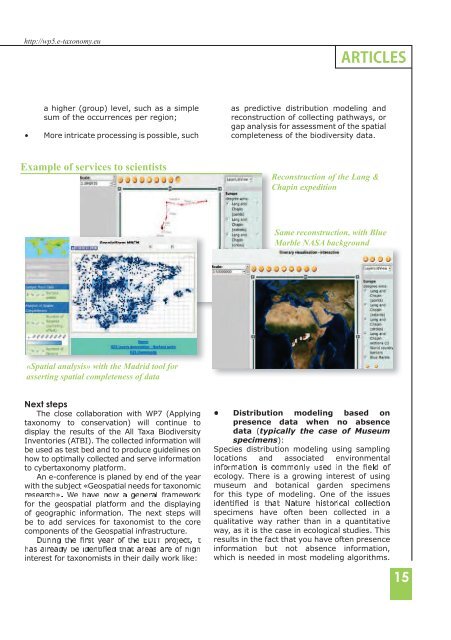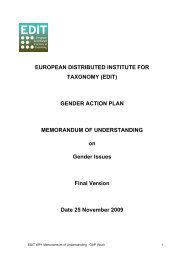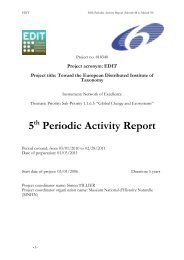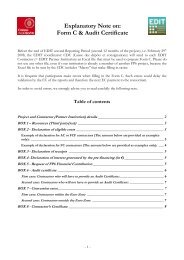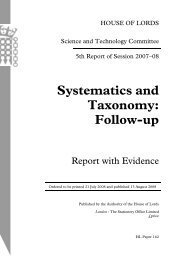Newsletter #5 - EDIT | - European Distributed Institute of Taxonomy
Newsletter #5 - EDIT | - European Distributed Institute of Taxonomy
Newsletter #5 - EDIT | - European Distributed Institute of Taxonomy
You also want an ePaper? Increase the reach of your titles
YUMPU automatically turns print PDFs into web optimized ePapers that Google loves.
•<br />
as<br />
•<br />
presence<br />
http://wp5.e-taxonomy.eu<br />
<br />
a higher (group) level, such as a simple<br />
sum <strong>of</strong> the occurrences per region;<br />
More intricate processing is possible, such<br />
predictive distribution modeling and<br />
reconstruction <strong>of</strong> collecting pathways, or<br />
gap analysis for assessment <strong>of</strong> the spatial<br />
completeness <strong>of</strong> the biodiversity data.<br />
Example <strong>of</strong> services to scientists<br />
Reconstruction <strong>of</strong> the Lang &<br />
Chapin expedition<br />
Same reconstruction, with Blue<br />
Marble NASA background<br />
«Spatial analysis» with the Madrid tool for<br />
asserting spatial completeness <strong>of</strong> data<br />
Next steps<br />
The close collaboration with WP7 (Applying<br />
taxonomy to conservation) will continue to<br />
display the results <strong>of</strong> the All Taxa Biodiversity<br />
Inventories (ATBI). The collected information will<br />
be used as test bed and to produce guidelines on<br />
how to optimally collected and serve information<br />
to cybertaxonomy platform.<br />
An e-conference is planed by end <strong>of</strong> the year<br />
with the subject «Geospatial needs for taxonomic<br />
for the geospatial platform and the displaying<br />
<strong>of</strong> geographic information. The next steps will<br />
be to add services for taxonomist to the core<br />
components <strong>of</strong> the Geospatial infrastructure.<br />
Duringthefirstyear<strong>of</strong>the<strong>EDIT</strong>project,it research».Wehavenowageneralframework<br />
interest for taxonomists in their daily work like:<br />
hasalreadybeidentifiedthatareasare<strong>of</strong>high<br />
Distribution modeling based on<br />
data when no absence<br />
data (typically the case <strong>of</strong> Museum<br />
specimens):<br />
Species distribution modeling using sampling<br />
locations and associated environmental<br />
informationiscommonlyusedinthefield<strong>of</strong><br />
ecology. There is a growing interest <strong>of</strong> using<br />
museum and botanical garden specimens<br />
for this type <strong>of</strong> modeling. One <strong>of</strong> the issues<br />
specimens have <strong>of</strong>ten been collected in a<br />
qualitative way rather than in a quantitative<br />
way, as it is the case in ecological studies. This<br />
results in the fact that you have <strong>of</strong>ten presence<br />
information but not absence information,<br />
which is needed in most modeling algorithms.<br />
identifiedisthatNaturehistoricalcollection<br />
15


